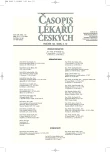Innate Immunity, Receptors for Exogenous and Endogenous Danger Patterns in Immunopathogenesis of Atherosclerosis – Part I: Identification of Danger Signals by Innate Immunity
Authors:
J. Krejsek; P. Kuneš 1; C. Andrýs; M. Holická; J. Novosad; M. Kudlová; M. Koláčková
Authors‘ workplace:
Ústav klinické imunologie a alergologie LF UK a FN, Hradec Králové
; Kardiochirurgická klinika FN, Hradec Králové
1
Published in:
Čas. Lék. čes. 2005; 144: 785-789
Category:
Review Article
Overview
Cellular and humoral components of innate immunity are able to identify danger signals both of the exogenous and endogenous origin. Exogenous danger signals are evolutionary conserved mosaics of danger patterns which are frequent in pathogenic microbes. Endogenous danger signals are raised during damage of self structures, by oxidative stress and/or by chemical modification of self molecules. Danger signals are identified by several families of molecules which are expressed on the surfaces of innate immunity cells. Among them the TLR receptors family which is associated with intracellular signaling pathway NF-κB is one of the most important. The inflammatory response is induced via activated NF-κB transcription factor.
Key words:
innate immunity, danger patterns, TLR receptors.
Labels
Addictology Allergology and clinical immunology Angiology Audiology Clinical biochemistry Dermatology & STDs Paediatric gastroenterology Paediatric surgery Paediatric cardiology Paediatric neurology Paediatric ENT Paediatric psychiatry Paediatric rheumatology Diabetology Pharmacy Vascular surgery Pain management Dental HygienistArticle was published in
Journal of Czech Physicians

Most read in this issue
- Renal Angiomyolipoma, Histology, Diagnostics and Therapy
- Mosaicplasty in the Treatment of Knee Injuries
- Cognitive Dysfunction and Its Therapy
- Combined Immunosuppressive Therapy in Patients with Pemphigus Vulgaris and Its Side Effects
